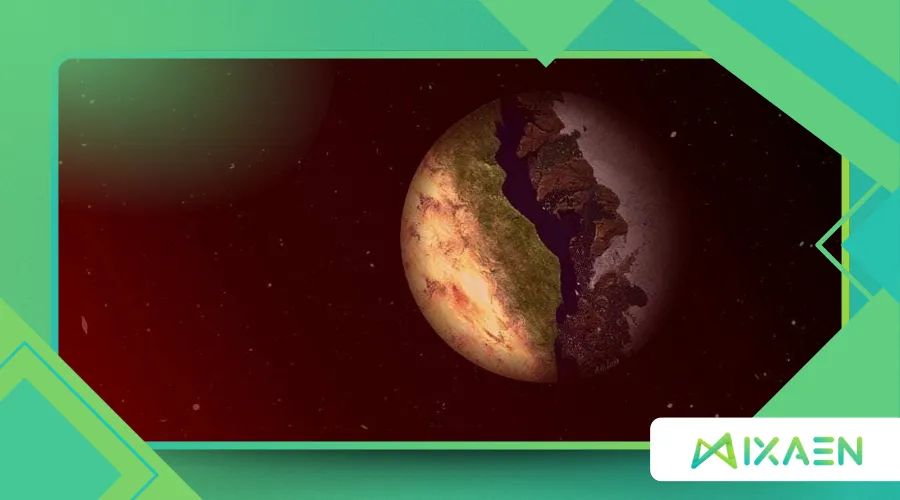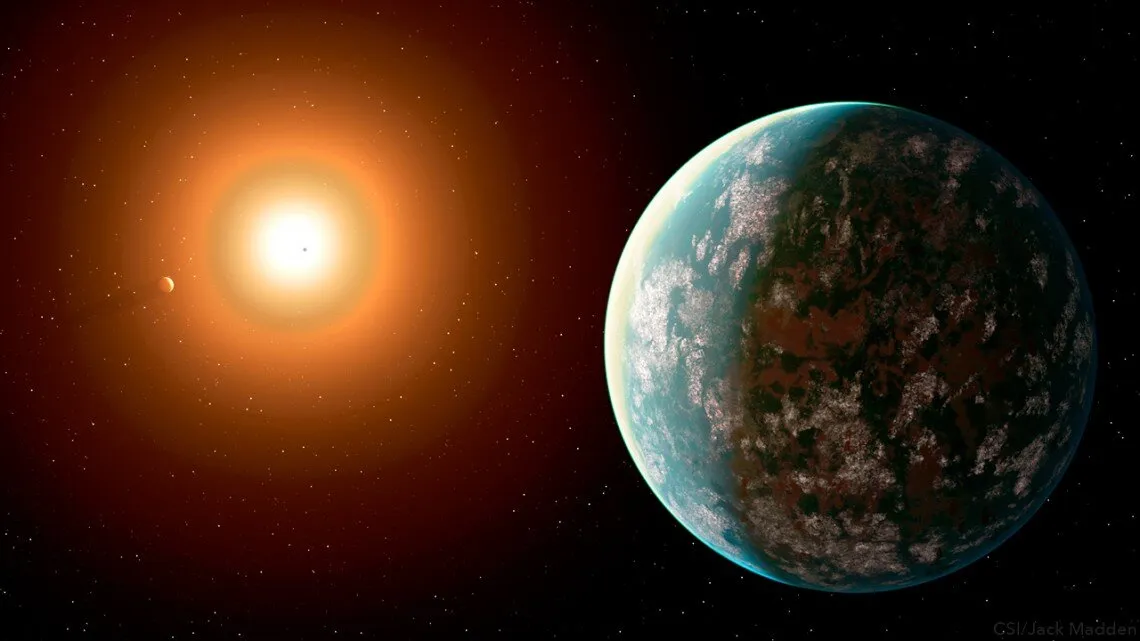What Tidally Locked Exoplanets Teach Us About Climate Extremes

Tidally locked exoplanets, where one side eternally faces their star, offer a cosmic laboratory for understanding climate extremes that challenge our notions of habitability.
Anúncios
These distant worlds, tethered in a gravitational dance with their stars, present environments so alien they push the boundaries of planetary science.
By studying them, we uncover insights into atmospheric dynamics, temperature gradients, and the delicate balance of conditions that sustain life—or prevent it.
This exploration not only deepens our grasp of extraterrestrial climates but also sharpens our perspective on Earth’s own vulnerabilities to extreme weather patterns.
Moreover, the study of these planets can inform future missions aimed at discovering habitable worlds beyond our solar system.
As technology advances, the potential to explore and understand these unique environments grows, paving the way for groundbreaking discoveries in astrobiology.
The Cosmic Tug-of-War: Understanding Tidal Locking
Imagine a planet caught in a celestial waltz, one face perpetually bathed in starlight, the other shrouded in eternal darkness.
This is the reality of tidally locked exoplanets, a phenomenon driven by gravitational forces that synchronize a planet’s rotation with its orbit.
Much like the Moon’s relationship with Earth, these exoplanets keep one hemisphere locked toward their star, creating a stark divide: a scorching dayside and a frigid nightside.
The boundary between them, known as the terminator zone, becomes a battleground of atmospheric forces.
This setup is common among exoplanets orbiting close to their stars, particularly red dwarfs, which are smaller and cooler than our Sun but host many known exoplanets.
A 2023 study published in The Astrophysical Journal found that approximately 70% of exoplanets within the habitable zones of M-dwarf stars are likely tidally locked, highlighting their prevalence.
This statistic underscores why these worlds are critical to understanding planetary climates: they represent a significant fraction of potentially habitable worlds, yet their extreme conditions test the limits of what “habitable” means.
Furthermore, the dynamics of tidal locking can also influence a planet’s potential for hosting life.
The unique environmental conditions created by tidal locking might lead to the development of distinct ecosystems, offering new avenues for understanding life’s adaptability.
A Tale of Two Hemispheres: Climate Dichotomy
The climate of tidally locked exoplanets is a study in contrasts.
The dayside, constantly scorched by stellar radiation, can reach temperatures hot enough to melt rock—sometimes exceeding 2,000°F (1,100°C) on planets like 55 Cancri e.
Meanwhile, the nightside, deprived of direct starlight, plunges into cryogenic cold, often dipping below -300°F (-184°C).
This dichotomy creates atmospheric dynamics unlike anything on Earth.
Winds, driven by massive temperature gradients, can whip across the planet at supersonic speeds, redistributing heat in ways that defy intuition.
Consider a hypothetical exoplanet, Kaelara-7b, orbiting a red dwarf 50 light-years away.
Its dayside is a molten desert, where silicate clouds condense and rain liquid rock.
The nightside, by contrast, is a frozen wasteland, with nitrogen ice coating the surface.
At the terminator, a narrow band of twilight hosts turbulent storms where hot and cold air masses collide.
This extreme gradient illustrates how tidally locked exoplanets amplify atmospheric processes, offering clues about heat transfer and storm formation that could inform Earth’s climate models.
Additionally, the unique temperature variations on these planets may lead to the formation of unusual weather patterns.
Understanding these patterns can help scientists predict how extreme climate conditions might manifest on Earth and elsewhere in the universe.
+ What Exoplanet Gravity Tells Us About Life’s Possibilities
The Terminator Zone: A Fragile Oasis?
Could life thrive in the twilight of a tidally locked exoplanet?
The terminator zone, where eternal sunrise or sunset moderates temperatures, is often touted as a potential haven for habitability.
Here, conditions might resemble Earth’s temperate regions, with liquid water possible under the right circumstances.
However, this zone is no serene paradise.
It’s a region of relentless atmospheric churn, where winds and storms rage as heat battles cold.
Take the example of Zorath-3c, an imagined tidally locked exoplanet with a dense atmosphere rich in carbon dioxide.
Models suggest its terminator zone could sustain liquid water lakes, but only if the atmosphere efficiently transports heat from the dayside.
If the winds falter, the nightside freezes solid, and the dayside becomes a furnace.
This precarious balance highlights a key lesson: habitability depends on atmospheric dynamics as much as proximity to a star.
Studying these worlds forces us to rethink what makes a planet livable, pushing us to consider factors like atmospheric composition and circulation patterns.
Moreover, the challenges of sustaining life in such extreme environments can provide insights into the resilience of life on Earth.
By understanding how potential life forms might adapt to these conditions, we can better appreciate the limits of life in our own environment.

Lessons for Earth: Amplifying Climate Models
Tidally locked exoplanets serve as extreme case studies for climate science.
Their stark temperature gradients and dynamic atmospheres mirror exaggerated versions of Earth’s own climate challenges.
For instance, Earth’s polar regions experience significant temperature differences between summer and winter, but these pale compared to the perpetual extremes of a tidally locked world.
By modeling these exoplanets, scientists refine tools used to predict Earth’s climate, particularly in scenarios involving rapid warming or cooling.
Consider the analogy of a tidally locked exoplanet as a pressure cooker for climate dynamics.
Just as a pressure cooker intensifies flavors by trapping heat, these planets amplify atmospheric processes, revealing how heat, moisture, and gases interact under extreme conditions.
Insights from these models can improve our understanding of Earth’s jet streams, hurricane formation, and heatwaves—phenomena growing more erratic as global temperatures rise.
For example, simulations of tidally locked exoplanets have shown how strong winds can stabilize temperature gradients, a principle that could inform strategies to mitigate extreme weather on Earth.
Additionally, by studying these extreme climates, researchers can develop more accurate predictive models for climate change impacts on Earth.
This knowledge is crucial for preparing for and adapting to the challenges posed by a changing climate.
++ How Planetary Rotation Shapes the Habitability of Exoplanets
Data Snapshot: Atmospheric Dynamics
To illustrate the extremes of tidally locked exoplanets, consider the following data comparing a tidally locked exoplanet to Earth:
| Parameter | Tidally Locked Exoplanet (e.g., Proxima b) | Earth |
|---|---|---|
| Dayside Temperature | ~500°F (260°C) | ~134°F (57°C, max) |
| Nightside Temperature | ~-280°F (-173°C) | ~-128°F (-89°C, min) |
| Wind Speeds (Terminator) | Up to 1,000 mph (1,600 km/h) | ~200 mph (320 km/h, max) |
| Atmospheric Circulation | Supersonic jets, global convection | Regional jet streams |
This table highlights the exaggerated conditions on tidally locked exoplanets, emphasizing their value as natural experiments for studying climate extremes.
Furthermore, analyzing these extreme conditions can help scientists identify potential warning signs for climate change on Earth.
By understanding how these planets respond to their environments, we can better anticipate the effects of climate change on our own planet.
Challenges in Observation: Peering into Alien Climates
Observing tidally locked exoplanets is no small feat.
Their proximity to host stars makes them difficult to image directly, and their extreme conditions complicate spectroscopic analysis.
However, advancements in telescopes like the James Webb Space Telescope (JWST) have opened new windows.
JWST’s ability to capture infrared emissions allows scientists to map temperature gradients and detect atmospheric compositions, offering clues about how these planets manage heat.
For instance, recent observations of LHS 3844b, a tidally locked super-Earth, revealed a thin atmosphere with minimal heat redistribution, suggesting a barren, airless world.
Such findings underscore the diversity of tidally locked exoplanets and the challenges of generalizing their climates.
Each planet’s unique combination of size, atmosphere, and stellar radiation shapes its climate, providing a rich dataset for refining climate models.
Moreover, ongoing advancements in observational technology will continue to enhance our understanding of these alien worlds.
As we refine our techniques, we may uncover new insights that challenge our current understanding of habitability and climate dynamics.

Implications for Habitability and Beyond
The study of tidally locked exoplanets challenges our assumptions about habitability.
While the terminator zone offers hope for life, the extreme conditions elsewhere raise questions about resilience.
Could microbes adapt to such harsh gradients?
This question pushes us to explore life’s limits, from Earth’s deep-sea vents to Antarctic ice sheets, and apply those lessons to alien worlds.
Moreover, these exoplanets inform our search for biosignatures.
Gases like oxygen or methane, detectable in an exoplanet’s atmosphere, could indicate life—but only if we understand how non-biological processes mimic those signals in extreme climates.
Tidally locked exoplanets, with their intense atmospheric dynamics, are ideal for testing these hypotheses, helping us distinguish true biosignatures from false positives.
Additionally, understanding the potential for life in extreme environments can inform our search for extraterrestrial life.
By expanding our definition of habitability, we can better target our explorations for signs of life beyond Earth.
Climate Extremes Compared: Exoplanets vs. Earth
To contextualize the lessons from tidally locked exoplanets, consider this comparison of climate extremes:
| Feature | Tidally Locked Exoplanet | Earth (Extreme Case) |
|---|---|---|
| Temperature Gradient | 800°F+ (444°C) between day/night sides | ~100°F (56°C) polar-equator |
| Dominant Weather Pattern | Supersonic winds, persistent storms | Hurricanes, monsoons |
| Potential for Liquid Water | Limited to terminator zone | Widespread, oceans |
| Atmospheric Stability | Highly dynamic, unstable | Relatively stable |
This table underscores how tidally locked exoplanets amplify climate processes, offering a lens to study Earth’s own vulnerabilities to extreme weather.
Moreover, examining these extremes can help us understand the thresholds beyond which climate systems may fail.
This knowledge is crucial for developing strategies to mitigate the impacts of climate change on our planet.
A Mirror to Earth’s Future?
As Earth grapples with climate change, tidally locked exoplanets offer a sobering perspective.
Their extreme conditions—unrelenting heat, bone-chilling cold, and violent winds—echo worst-case scenarios for our planet.
Rising global temperatures could intensify weather patterns, much like the atmospheric chaos seen on these distant worlds.
By studying how tidally locked exoplanets balance heat and cold, scientists can better predict how Earth’s climate might respond to continued warming.
The lessons are clear: climate systems are fragile, and small disruptions can cascade into chaos.
Tidally locked exoplanets remind us that habitability is not guaranteed—it’s a delicate equilibrium, easily tipped by stellar forces or human activity.
Their study isn’t just about understanding alien worlds; it’s about safeguarding our own.
Additionally, the insights gained from these distant worlds can inspire innovative solutions to the climate crisis on Earth.
By applying these lessons, we can work toward a more sustainable future.
For more information on exoplanets and their climates, check out NASA’s Exoplanet Exploration.
Conclusion: A Cosmic Warning and Opportunity
Tidally locked exoplanets are more than astronomical curiosities—they’re mirrors reflecting the fragility and complexity of planetary climates.
By probing their extremes, we gain insights into atmospheric dynamics, heat transfer, and the conditions that sustain life.
These worlds challenge us to refine our climate models, rethink habitability, and confront the risks facing Earth.
As we peer into their twilight zones and scorching daysides, we’re reminded of a universal truth: climate is a cosmic force, shaping worlds from our own to those light-years away.
Will we heed the lessons of these distant planets to protect our own?
The answers lie in the stars—and in our resolve to act.
This site provides a wealth of resources on the discovery and study of exoplanets, enhancing our understanding of these fascinating worlds.
